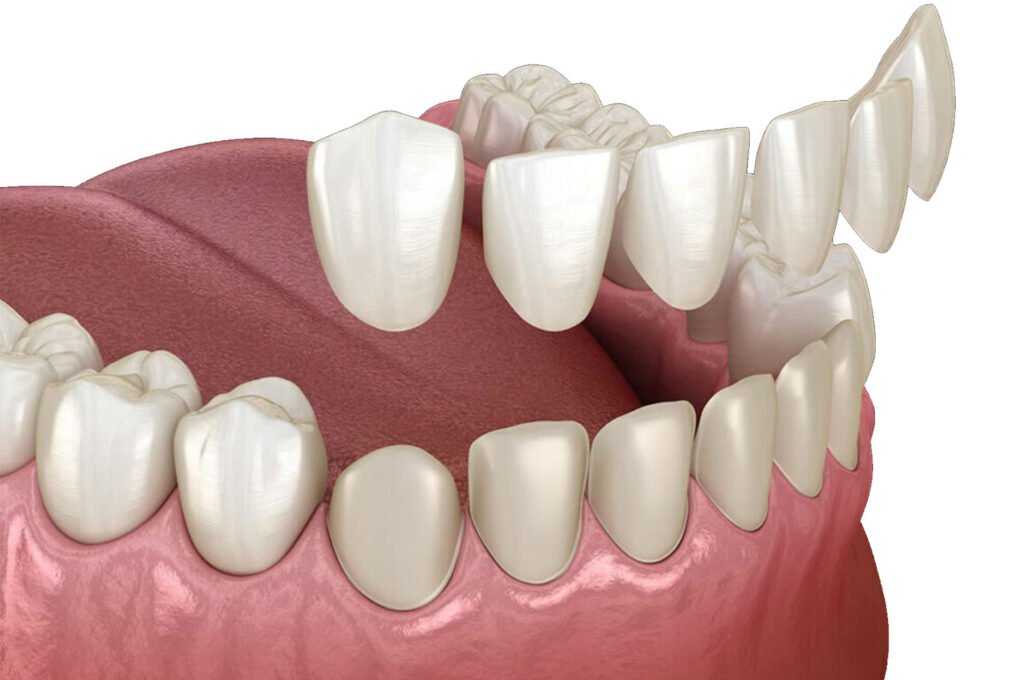
Veneers are thin shells of tooth-colored material (usually porcelain or composite resin) that are bonded to the front surface of teeth to improve their appearance. They are a popular cosmetic dentistry option for creating a beautiful, natural-looking smile.
Types of Veneers
- Porcelain Veneers:
- Made from high-quality ceramic material.
- Highly resistant to stains.
- Mimic the light-reflecting properties of natural teeth.
- More durable and longer-lasting compared to composite veneers.
- Typically require more tooth enamel to be removed before placement.
- Composite Resin Veneers:
- Made from tooth-colored resin material.
- Less expensive than porcelain veneers.
- Require less enamel removal.
- Can be applied in a single visit.
- May not last as long as porcelain veneers and can be more prone to staining and chipping.
Indications for Veneers
Veneers are used to address a variety of dental issues, including:
- Discolored teeth: Due to stains from food, drinks, smoking, or medications.
- Worn-down teeth: From grinding or other habits.
- Chipped or broken teeth.
- Misaligned, uneven, or irregularly shaped teeth.
- Gaps between teeth.
Procedure for Veneers
- Consultation:
- The process begins with a consultation with a dentist to discuss the patient’s goals and determine if veneers are suitable.
- X-rays and impressions of the teeth may be taken.
- Preparation:
- For porcelain veneers, a small amount of enamel (usually about 0.5 mm) is removed from the front surface of the teeth to make room for the veneers.
- For composite veneers, minimal enamel removal may be needed.
- Impressions of the teeth are taken to create custom veneers.
- Temporary Veneers:
- Temporary veneers may be placed while the permanent veneers are being fabricated in a dental laboratory (typically for porcelain veneers).
- Bonding:
- Once the custom veneers are ready, the dentist will place them on the teeth to check the fit and color.
- The teeth are cleaned, polished, and etched to create a rough surface for better bonding.
- Dental cement is applied to the veneer, which is then placed on the tooth.
- A special light is used to harden the cement, securing the veneer in place.
- Final adjustments are made to ensure a perfect fit and comfortable bite.
Benefits of Veneers
- Natural Appearance: Veneers provide a realistic and attractive appearance, closely resembling natural teeth.
- Stain Resistance: Porcelain veneers are particularly resistant to stains from coffee, tea, and smoking.
- Durability: With proper care, veneers can last 10-15 years or longer.
- Minimally Invasive: Compared to crowns, veneers require less removal of the tooth’s original structure.
Care and Maintenance
- Oral Hygiene: Brush and floss regularly to maintain oral health and extend the life of veneers.
- Avoid Hard Foods: Chewing on hard objects like ice or pens can damage veneers.
- Regular Dental Visits: Routine check-ups and cleanings are essential to monitor the condition of the veneers and overall oral health.
- Mouthguards: If you grind your teeth at night, wearing a mouthguard can protect your veneers.
Potential Risks and Considerations
- Irreversibility: The process of applying veneers is often irreversible because enamel is removed.
- Sensitivity: Some patients may experience increased tooth sensitivity to hot and cold temperatures.
- Cost: Veneers can be expensive, especially porcelain veneers, and they may not be covered by insurance if done for cosmetic reasons.
- Repair and Replacement: Veneers can chip or break, and while composite veneers can be repaired easily, porcelain veneers usually need to be replaced.

